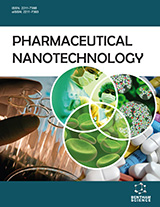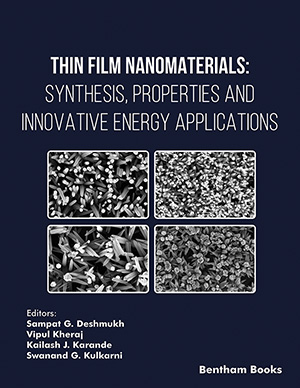[1]
Li D, Ma M. Cyclodextrin polymer separation materials. WO9822197 1998.
[2]
Trotta F, Cavalli R. Ultrasound assisted synthesis of cyclodextrin based nanosponges. WO0002814A1 2006.
[3]
Trotta F, Zanetti M, Cavalli R. Cyclodextrin-based nanosponges as drug carriers. Beilstein J Org Chem 2012; 8: 2091-9.
[4]
Trotta F, Cavalli R. Characterization and applications of new hyper-cross-linked Cyclodextrins. Compos Interfaces 2009; 16: 39-48.
[5]
Tejashri G, Amrita B, Darshana J. Cyclodextrin based nanosponges for pharmaceutical use: a review. Acta Pharm 2013; 63(3): 335-58.
[6]
Sherje AP, Dravyakar BR, Kadam D, Jadhav M. Cyclodextrin-based nanosponges: a critical review. Carbohydr Polym 2017; 173: 37-49.
[7]
Shankar S, Pradeep R, Francesco T, et al. Structural evidence of differential forms of nanosponges of beta-cyclodextrin and its effect on solubilization of a model drug. J Incl Phenom Macrocycl Chem 2013; 76: 201-11.
[8]
Shankar S, Vavia PR, Francesco T, Satyen T. Formulation of betacyclodextrin based nanosponges of itraconazole. J Incl Phenom Macrocycl Chem 2007; 57: 89-94.
[9]
Monica R, Amrita B, Ishwar K, Ghanshyam M, Francesco T. In vitro and in vivo evaluation of b-cyclodextrin-based nanosponges of telmisartan. J Incl Phenom Macrocycl Chem 2012; 12: 224-7.
[10]
Darandale S, Vavia P. Cyclodextrin-based nanosponges of curcumin: formulation and physicochemical characterization. J Incl Phenom Macrocycl Chem 2012; 75: 315-22.
[11]
Barbara M, Alessandro B, Silvia M, et al. In vitro enhancement of anticancer activity of paclitaxel by a Cremophor free cyclodextrin-based nanosponge formulation. Incl Phenom Macrocycl Chem 2012; 74: 201-10.
[12]
Mufassir M, Zahid Z, Rana Z, Jaiprakash N. Extended release delivery of erlotinib glutathione nanosponges for targeting lung cancer. Artif Cells Nanomed Biotechnol 2018; 45(8): 1064-75.
[13]
Trotta F, Dianzani C, Caldera F, Mognetti B, Cavalli R. The application of nanosponges to cancer drug delivery. Expert Opin Drug Deliv 2014; 11(6): 931-41.
[15]
Mughal TI, Schrieber A. Principal long-term adverse effects of imatinib in patients with chronic myeloid leukemia in chronic phase. Biologics 2010; 4: 315-23.
[16]
Rao MR, Bhingole RC, Rohini C. Nanosponge-based pediatric-controlled release dry suspension of Gabapentin for reconstitution. Drug Dev Ind Pharm 2015; 41(12): 2029-36.
[17]
Moore GE, Gerner RE, Franklin HA. Culture of normal human leukocytes. JAMA 1967; 199(8): 519-24.
[18]
Lee Y-L, Chen C-W, Liu F-H, Huang Y-W, Huang H-M. Aclacinomycin A sensitizes K562 chronic myeloid leukemia cells to imatinib through p38MAPK-mediated erythroid differentiation. PLoS One 2013; 8(4)e61939
[19]
Momin MM, Zaheer Z, Zainuddin R, Sangshetti JN. Extended release delivery of erlotinib glutathione nanosponge for targeting lung cancer. Artif Cells Nanomed Biotechnol 2018; 46(5): 1064-75.
[20]
Sadat Shandiz SA, Shafiee Ardestani M, Shahbazzadeh D, et al. Novel imatinib-loaded silver nanoparticles for enhanced apoptosis of human breast cancer MCF-7 cells. Artif Cells Nanomed Biotechnol 2017; 45(6): 1-10.
[21]
Mehdizadeh M, Rouhani H, Sepehri N, et al. Biotin decorated PLGA nanoparticles containing SN-38 designed for cancer therapy. Artif Cells Nanomed Biotechnol 2017; 45(3): 495-504.
[22]
Cho EC, Xie J, Wurm PA, Xia Y. Understanding the role of surface charges in cellular adsorption versus internalization by selectively removing gold nanoparticles on the cell surface with a I2/KI etchant. Nano Lett 2009; 9(3): 1080-4.
[23]
Xiao W, Chen WH, Xu XD, et al. Design of a cellular-uptake-shielding “plug and play” template for photo controllable drug release. Adv Mater 2011; 23(31): 3526-30.
[24]
Gambacorti-Passerini C, Zucchetti M, Russo D, et al. α1 acid glycoprotein binds to imatinib (STI571) and substantially alters its pharmacokinetics in chronic myeloid leukemia patients. Clin Cancer Res 2003; 9(2): 625-32.
[25]
Gambacorti-Passerini C, Barni R, le Coutre P, et al. Role of α1 acid glycoprotein in the in vivo resistance of human BCR-ABL(+) leukemic cells to the abl inhibitor STI571. J Natl Cancer Inst 2000; 92(20): 1641-50.
[26]
Shankar S, Pradeep V, Francesco T, et al. Structural evidence of differential forms of nanosponges of beta-cyclodextrin and its effect on solubilisation of a model drug. J Incl Phenom Macrocycl Chem 2013; 76: 201-11.































